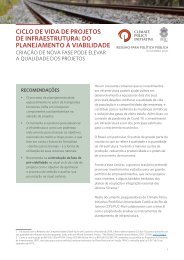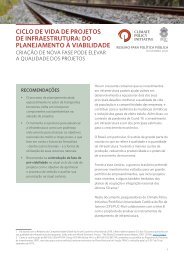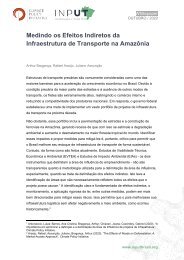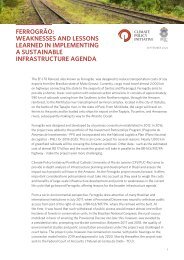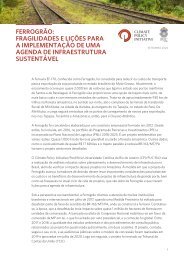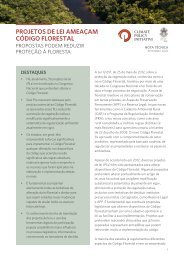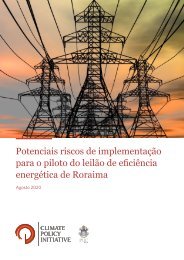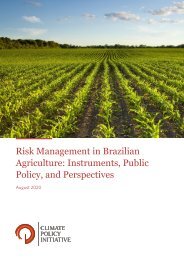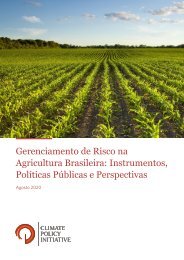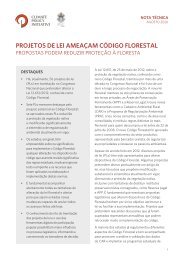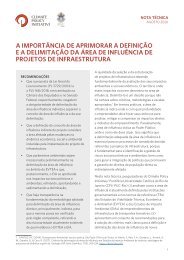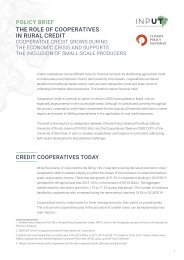The Need to Better Define and Delimit Area of Influence for Infrastructure Projects
You also want an ePaper? Increase the reach of your titles
YUMPU automatically turns print PDFs into web optimized ePapers that Google loves.
that most <strong>of</strong> the dem<strong>and</strong> <strong>for</strong> the railroad will be from producers in the mid-north region <strong>of</strong> the<br />
state <strong>of</strong> Ma<strong>to</strong> Grosso, many <strong>of</strong> whom are located hundreds <strong>of</strong> kilometers away from the railroad.<br />
This means that the implementation <strong>of</strong> this project will have indirect socio-environmental<br />
impacts on this region, which, due <strong>to</strong> the definition <strong>and</strong> criteria proposed in this technical<br />
note, should be included in its area <strong>of</strong> influence from the very beginning. <strong>The</strong> EVTEA also<br />
includes several parameters about the project itself - such as the location <strong>of</strong> construction sites,<br />
construction time, etc. - that can be used <strong>to</strong> delimit the area <strong>of</strong> direct influence from the outset.<br />
<strong>The</strong> final shape <strong>of</strong> the area <strong>of</strong> influence must benefit from refinements <strong>to</strong> the con<strong>to</strong>ur through<br />
the addition <strong>of</strong> other criteria <strong>to</strong> be determined by law - <strong>for</strong> example, about l<strong>and</strong>s belonging <strong>to</strong><br />
traditional communities or other sensitive areas.<br />
RECOMMENDATIONS FOR DEFINING<br />
AND DELIMITING THE AREA OF INFLUENCE<br />
<strong>The</strong> use <strong>of</strong> more consistent <strong>and</strong> clear criteria <strong>for</strong> delimiting areas <strong>of</strong> influence is key <strong>to</strong> improving<br />
the delimitation process. Currently, the conceptualization <strong>of</strong> the area <strong>of</strong> influence is <strong>of</strong>ten mixed<br />
with its delimitation. To assuage this confusion, the first recommendation <strong>of</strong> this technical<br />
note is that the concept <strong>and</strong> definition <strong>of</strong> area <strong>of</strong> influence be revisited <strong>and</strong> separated from its<br />
delimitation.<br />
A clear definition <strong>of</strong> the concept <strong>of</strong> area <strong>of</strong> influence, facilitates the determination <strong>of</strong> the most<br />
suitable criteria <strong>for</strong> delimiting the area in question. In this sense, the second recommendation <strong>of</strong><br />
this technical note is that one <strong>of</strong> the criteria used <strong>to</strong> define a project’s area <strong>of</strong> influence includes<br />
any area affected by changes <strong>to</strong> its economic, social <strong>and</strong> environmental dynamics caused by<br />
the implementation <strong>of</strong> an infrastructure project. This will avoid the use <strong>of</strong> purely geographical<br />
parameters as mentioned earlier. It is important <strong>to</strong> note that this technical note does not propose<br />
that this be the only criterion used in delimiting areas <strong>of</strong> influence, but rather that it be used as<br />
one <strong>of</strong> several criteria when defining this area.<br />
Once the concept <strong>and</strong> criteria <strong>for</strong> delimiting the area <strong>of</strong> influence <strong>of</strong> l<strong>and</strong> transportation<br />
infrastructure projects have been determined, one must decide when in the project cycle<br />
the area will begin <strong>to</strong> be delimited <strong>and</strong> studied. As such, the third recommendation <strong>of</strong> this<br />
technical note is that environmental impacts be incorporated in<strong>to</strong> the definition <strong>of</strong> the area <strong>of</strong><br />
influence as early as in the EVTEA. This makes conceptual sense, as these impacts affect the<br />
social costs <strong>and</strong> benefits <strong>of</strong> the project <strong>and</strong> thus influence its economic feasibility. It also makes<br />
practical sense, as it allows the EIA <strong>to</strong> refine <strong>and</strong> add further detail <strong>to</strong> an environmental analysis<br />
conducted be<strong>for</strong>eh<strong>and</strong>.<br />
Finally, transparency is essential. Previous sections have shown how the differences in the criteria<br />
used in the definition <strong>and</strong> delimitation <strong>of</strong> areas <strong>of</strong> influence by different agencies <strong>and</strong> at different<br />
stages in the infrastructure project cycle causes significant confusion <strong>and</strong> insecurity. <strong>The</strong>re<strong>for</strong>e,<br />
the fourth recommendation <strong>of</strong> this technical note is that the preparation <strong>of</strong> studies (EVTEA <strong>and</strong>/<br />
or EIA) be based on clear <strong>and</strong> transparent methodologies that can be checked by competent<br />
bodies so as <strong>to</strong> eliminate the discretion project leaders enjoy in the current model.<br />
7




